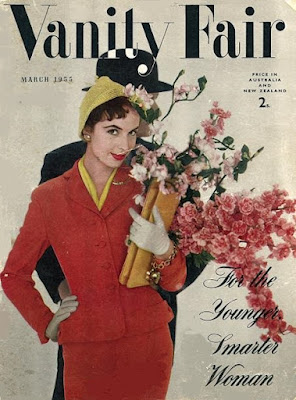Presenting another one of my colour-coded posts. As I looked through my collection of images recently, I noticed that there were a lot of green clothes scattered through the postwar 1940s. That made the choice of a colour easy, but the trick was to choose a date. Finally I decided on 1948, the year when the "New Look" became generally accepted.
 |
| Fashion, June 1948 |
From June 1948 comes a dress for dancing in green and gold. Created by Curzon's in Sydney, and modelled by Patty Lou Haas.
 |
| Modes de Paris, July 1948 |
Modes de Paris has an illustration (in green, of course) of a tent coat with large patch pockets on its July 1948 cover. A pattern for making it was available from the magazine.
 |
| National Bellas Hess, Fall and Winter 1948 |
The National Bellas Hess catalog of Fall and Winter 1948 showcased another green coat on its cover. In "Fine All Wool" and "Richly Trimmed" in fur-effect fabric, it was double breasted and featured a detachable, reversible hood.
 | ||
| McCall Style News, October 1948 |
McCall Style News depicts a full skirt (pattern 7193) in green plaid. The pattern was in two parts, measured three yards around, and was cut on the bias.
 |
| Stitchcraft, December 1948 |
To end the year, Stitchcraft featured this pattern for a knitted jacket. It included its own cozy hood, and zipped up the front. Stitchcraft was published in Britain where clothes rationing was still in force in 1948. I'm beginning to suspect that at least some of these green garments were made out of army surplus!
























